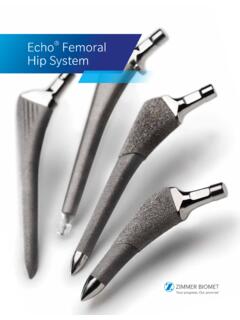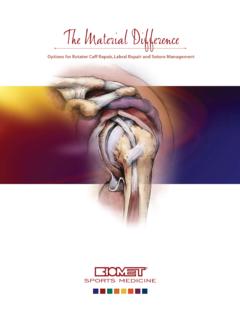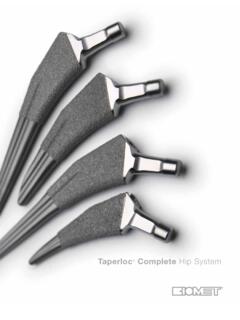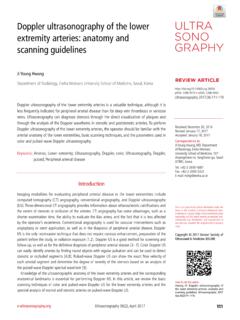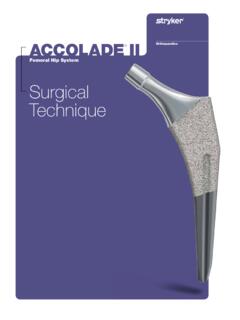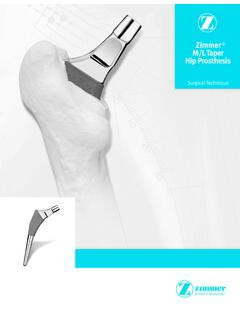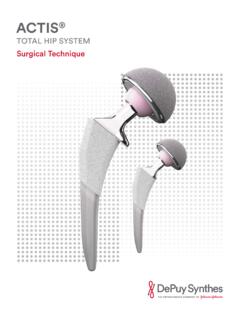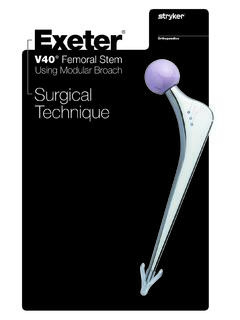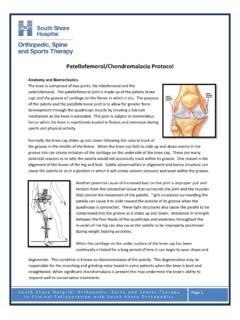Transcription of Zimmer Biomet CoCr and Ceramic Femoral Heads Surgical ...
1 Zimmer Biomet CoCr and Ceramic Femoral HeadsSurgical TechniqueFemoral Heads are intended for mating with titanium alloy, cobalt-chromium molybdenum alloy, cobalt-chromium-nickel-molybdenum alloy and stainless steel Femoral specific product compatibility, reference the following compatibility website: Biomet CoCr Femoral Heads and Freedom Constrained Heads are made from cobalt-chromium molybdenum alloy. They are manufactured to include a 12/14 taper or Type I taper and are offered in a variety of head diameters and neck configurations. See the applicable Ordering Information document for detailed product Femoral HeadsCoCr Femoral HeadsZimmer Biomet offers Ceramic Heads that are made from an aluminum oxide matrix composite Ceramic in accordance with ISO 6474-2.
2 Ceramic Femoral Heads are offered in non-sleeved and sleeved designs. Non-sleeved Heads are manufactured to include a 12/14 taper or Type I taper. Sleeved options include taper adaptors compatible with 12/14, Type 1 and 6 Femoral stem tapers. See the applicable Ordering Information document for detailed product Ceramic Femoral Heads should only be implanted on pristine/non-damaged stems. In revision cases, a sleeved Ceramic Femoral head with a taper adaptor should be Zimmer Biomet Ceramic Heads are intended for use as a component of a total hip or hemi-hip prosthesis in primary and revision patients. Refer to the Zimmer Biomet Ceramic Heads package insert for the indications for not couple mm Ceramic head sizes with cobalt-chrome or stainless steel Femoral stems.
3 Generally, these materials impose higher stresses on the Ceramic Femoral HeadsTable of ContentsPreoperative Planning ..1 Spherical and Freedom Constrained CoCr Femoral Heads ..2 Non-Sleeved Ceramic Femoral Head ..4 Sleeved Ceramic Femoral Head ..61 | Zimmer Biomet CoCr and Ceramic Femoral Heads Surgical TechniqueFigure 1 When performing a revision of the acetabular component only, it is important to identify the stem which will remain in situ during the pre-operative planning. This will help select the appropriate CoCr Femoral head type or the right taper adaptor for a Ceramic head. The inner taper of the head adapter must fit the stem PlanningPre-operative PlanningThe objectives of pre-operative planning are to define: Pre-operative leg length Acetabular component size and position Femoral component size Femoral offset and center of rotationX-ray templates and digital templates, for some brands, are provided with acetabular and Femoral | Zimmer Biomet CoCr and Ceramic Femoral Heads Surgical TechniqueFigure 2 Figure 4 Figure 3 Trial ReductionPerform a trial to assess leg length, range of motion, stability and abductor tension (Figure 3).
4 Repeat as necessary until optimal offset and leg length are established making any necessary adjustments to restore joint mechanics, range of motion and stability. Make certain that prominent impinging bone and/or osteophytes are removed from the periphery of the acetabulum to maximize range of motion and for Freedom Constrained Heads : Only Freedom provisional Heads are compatible for trialing with Freedom implant liners. Never mix the implant components and the provisional components to perform a trial Head TrialSelect the correct provisional head that matches the stem taper (Figure 2). Visually inspect the trial Heads for damage prior to use.
5 Select the appropriate head diameter and offset to create equal leg length and needed and Freedom Constrained CoCr Femoral Heads3 | Zimmer Biomet CoCr and Ceramic Femoral Heads Surgical TechniqueFigure 4 Figure 6 Final ReductionOnce all final implants have been placed, reduce the hip and assess leg length, range of motion, stability, and abductor tension (Figure 6). Femoral Head ImpactionThoroughly clean and dry the implant trunnion taper. Assemble the appropriate mating CoCr Femoral head onto the stem taper. Impact the Femoral head with at least one hard mallet strike using the Femoral head impactor axially aligned on the Femoral head to the stem taper (Figure 4).
6 Test the security of the head fixation by trying to remove it by for Freedom Constrained Heads : Make sure to position the Freedom head on the stem so that the etch marking on the head is located in the most superior position prior to impaction (Figure 5).Figure 5 Freedom Etching4 | Zimmer Biomet CoCr and Ceramic Femoral Heads Surgical TechniqueFigure 7 Figure 8 Trial ReductionPerform a trial reduction to assess leg length, range of motion, stability, and abductor tension (Figure 8). Repeat as necessary until optimal offset and leg length are established making any necessary adjustments to restore joint mechanics, range of motion and certain that prominent impinging bone and/or osteophytes are removed from the periphery of the acetabulum to help maximize range of motion and Head TrialSelect the correct provisional that matches the stem taper (Figure 7).
7 Visually inspect the provisional Heads for damage prior to use. Select the appropriate head diameter and offset to create equal leg length and needed Ceramic Femoral Head5 | Zimmer Biomet CoCr and Ceramic Femoral Heads Surgical TechniqueFigure 11 Final ReductionOnce all final implants have been placed, reduce the hip and assess leg length, range of motion, stability, and abductor tension (Figure 11). Femoral Head ImpactionThoroughly clean and dry the implant trunnion the non-sleeved Ceramic Femoral head onto the stem taper by gently turning it (Figure 9). Impact the Femoral head with at least one light mallet strike using the Femoral head impactor axially aligned on the Femoral head to the stem taper.
8 Impact the head with a plastic Femoral head impactor only (Figure 10). Test the security of the head fixation by trying to remove it by not couple mm Ceramic head sizes with cobalt-chrome or stainless steel Femoral stems. Generally, these materials impose higher stresses on the Ceramic head. Note: The use of metal impactors or any other metallic objects may scratch or crack the modular head bearing surface, compromising the integrity of the component. If the modular Ceramic head becomes scratched or cracked, the head and neck sleeve (if using a sleeved component) must be replaced. Figure 9 Figure 106 | Zimmer Biomet CoCr and Ceramic Femoral Heads Surgical TechniqueIntolerable ConditionUsed stem tapers with a score of 4 as described by Goldberg: >10% of taper surface containing black debris, pits, or etch marks Several bands of fretting scars involving several adjacent machine lines, or flattened areas with nearby fretting scars A taper with a scratch/defect at a height of mm, taper with a broad truncation, slanted taper or a crushed taper are all intolerable taper conditions.
9 Note: Sleeved Ceramic Femoral Heads must not be used with tapers that exhibit these intolerable condition characteristics (Figure 12).Stem Trunnion Inspection - Acetabular/Head revisionThe sleeved Ceramic Femoral head can be used on either a new/pristine stem or a previously implanted stem. If the Ceramic Femoral head is being used with a previously implanted stem, use the Goldberg1 scale to determine if the condition of the trunnion is tolerable or intolerable. Tolerable ConditionUsed stem tapers displaying fine marks from head/stem disassembly and/or up to, and including a score of 3 as described by Goldberg: Taper surface discolored or dull <10% of taper surface containing black debris, pits, or etch marksSleeved Ceramic Femoral HeadTaper with broad truncationSlanted taperCrushed taperTaper with scratch/defect at a height of mmFigure 127 | Zimmer Biomet CoCr and Ceramic Femoral Heads Surgical TechniqueAssembly InstructionsVerify the correct selection of both the Ceramic Femoral head and the neck sleeve as predetermined during the trialing process.
10 Assemble the modular head components prior to positioning them onto the stem. Align the head onto the neck sleeve axially and apply pressure (Figure 15 and 16). A slight resistance will be felt once the taper is engaged. Note: Heads and neck sleeves may be packaged either together or separately. See ordering information for detailed packaging 13 Figure 15 Figure 14 Figure 16 Femoral Head TrialVerify the taper type on the existing stem if performing an acetabular only revision, or the stem to be inserted, and select the correct provisional that matches the stem taper (Figure 13). Using the appropriate Femoral head provisionals, perform a trial reduction as detailed in previous sections (F igure 14).
